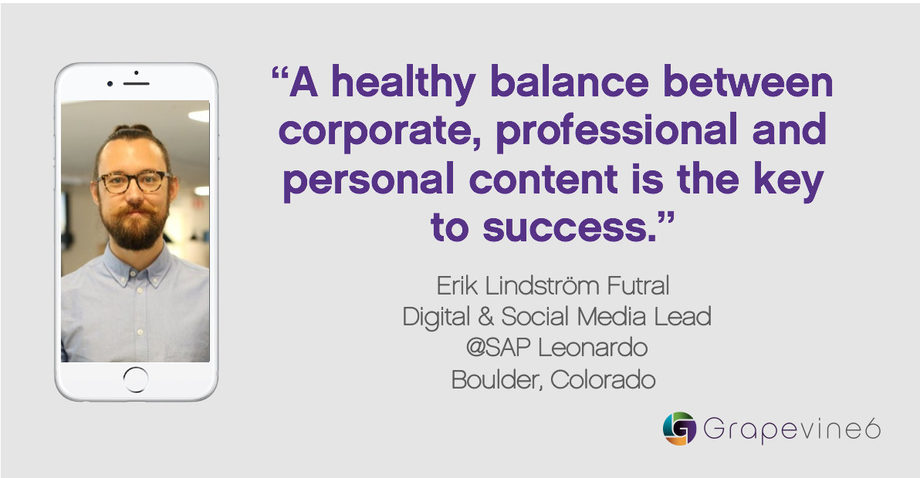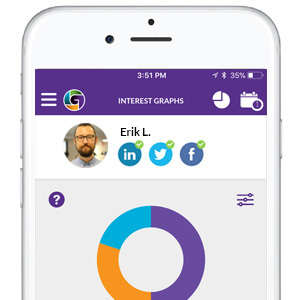How to be a Social Seller without being too “Salesy.”
SAP has trained more than 12,000 employees on Social Selling including how to use tools such as LinkedIn Sales Navigator, Voicestorm, Twitter, Videolicious and Grapevine6 to identify prospects, generate leads, build pipeline and win business. In this series of blog posts, you’ll hear from Social Selling frontrunners, in their own words, on how they use these tools to drive success and how Social Selling has helped them in their roles.

The forth interview in our series is with Erik Lindström Futral, the Digital and Social Media Lead for SAP Leonardo. Erik is based in Boulder, Colorado and shares some practical tips about content from his experience as a Social Selling trainer.
About Erik Lindström Futral
I am the Digital and Social Media Lead for SAP Leonardo. Previously, I was the Head of Social Business, EMEA, at SAP, where I was certified early on as a Social Selling trainer to conduct training sessions on why Social Selling and social media are vital to sales, and how to best use them.
Becoming a successful social seller
The first thing buyers likely do when they hear about you is Google your name. Creating a strong “digital-first” impression is critical because your end goal is to influence the buyer to get in touch with you and engage in a conversation. Social media profile optimization is key, especially on LinkedIn – because it all starts with that first digital impression. This isn’t just necessary, it’s mandatory!
Sharing without being “salesy”
When it comes to sharing great content, the first step is finding content that’s not only shareable, but also isn’t too “salesy.” Remember – your goal is to engage your audience where they spend their time and while you have their attention. Capturing their attention is one thing, but if your audience finds your content to be too salesy, they will likely lose interest and possibly even refrain from engaging with you in the future. You can speak very positively about the company you work for without being salesy – you can influence online discussions to show what your company can do. For example, I’ve had sales reps at SAP tell me their prospects had no idea of the depth of SAP’s capabilities until they started sharing content and participating in online discussions.
You can get started by finding relevant and shareable content using a tool like Grapevine6, a content engagement platform. One of its strengths is that it’s customizable to you and your specific interests. It’s possible to find not only company-specific content but also 3rd-party content around specific topic areas that are relevant to you. You can add specific keywords to your interest graph relating to professional and personal interests, and then easily share to your social networks.
The line between professional and personal content.
One of the most interesting challenges of Social Selling is finding the overlap between professional and personal content. If you only share your company’s content you’ll just be another corporate voice, but if you share only personal content, you’ll lose the business connection to your audience. No one wants to read only about your company, products or solutions; people see right through that. There’s no sense of camaraderie, human touch, or real connection with your audience. For example, you might be interested in photography – a non-business-related topic. Something like this, a potential shared interest, could be an opener with one of your prospects – a commonality. Once the connection is there it’s up to you as the thought leader to move the conversation towards your end goal. A healthy balance between corporate, thought-leadership and personal content is the key to success, while keeping the interactions genuine.
A Social Selling success story
I have a great success story regarding a sales rep in Norway, Josef Nalbant. He energetically went through a Social Selling training course, optimized his social profiles, and started posting and engaging. In collaboration with his local marketing lead, Ann Kristin Aannerud, he planned for and began using LinkedIn InMails to reach new audiences, and his phone just blew up with prospects responding to his messages. He got about 10 to 15 meetings set up within a day and grew his network exponentially. The reason for his success was the way he personalized his InMails. If the content isn’t personalized the reader won’t be attached to it.
Responding to Social Selling skeptics
Social and digital tactics have been around for a long time and they complement traditional sales tactics. It doesn’t mean you’ll never make a cold call or send a physical piece of mail again, but it’s an additional and necessary complement. The customer journey has changed so much in the last few years, but by using social and digital it enables us to be active where the customer is active regardless of where they are in their journey.
Becoming a thought leader through social sharing
A component of Social Selling is being able to educate your audience, and hopefully provide them with relevant content that will help them solve problems. Becoming an industry expert – by sharing relevant content – is where you can be most helpful to the buyer. The one thing I always do is read the content before I share it. Sure, the point of using content repository tools is to find content easily, but it’s important that the content is interesting to you and something you can stand behind.
